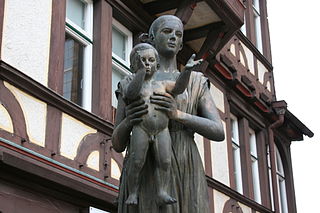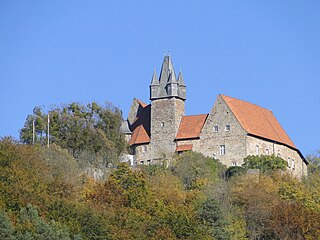
Hesse or Hessia, officially the State of Hesse, is a state in Germany. Its capital city is Wiesbaden, and the largest urban area is Frankfurt, which is also the country's principal financial centre. Two other major historic cities are Darmstadt and Kassel. With an area of 21,114.73 square kilometers and a population of over six million, it ranks seventh and fifth, respectively, among the sixteen German states. Frankfurt Rhine-Main, Germany's second-largest metropolitan area, is mainly located in Hesse.

Fritzlar is a small town in the Schwalm-Eder district in northern Hesse, Germany, 160 km (99 mi) north of Frankfurt, with a storied history.

Henry I of Hesse "the Child" was the first Landgrave of Hesse. He was the son of Henry II, Duke of Brabant and Sophie of Thuringia.

Felsberg is a town in the Schwalm-Eder district about 25 kilometres south of Kassel.

Gudensberg is a small town in northern Hesse, Germany. Since the municipal reform in 1974, the nearby villages of Deute, Dissen, Dorla, Gleichen, Maden and Obervorschütz have become parts of the municipality.
Heiligenberg is a municipality and a village in the Bodensee district, Baden-Württemberg, Germany.

The Ludovingians or Ludowingians were the ruling dynasty of Thuringia and Hesse during the 11th to 13th centuries.

Wolfershausen is one of the sixteen constituent communities that form the town of Felsberg in Schwalm-Eder-Kreis, North Hesse, Germany.
Eppenberg Charterhouse was a charterhouse, or Carthusian monastery, now a ruin, situated on the Eppenberg next to the Heiligenberg in Gensungen, now part of Felsberg in Hesse, Germany. It was established to replace a failing monastery of Premonstratensian canonesses.
Hedwig of Gudensberg, also known as Hedwig of Hesse (1098–1148) was German regent: she served as regent of Thuringia during the minority of her son Louis II from 1140.
Giso IV, Count of Gudensberg was a German nobleman. He was a Count in the Upper Lahngau and from 1121, he was Count of Gudensberg in Lower Hesse and Imperial Standard Bearer. During his lifetime, the Gisones dynasty reached the peak of its power, its largest territorial expanse and the largest number of bailiff positions.
Conrad of Dhaun was a German nobleman. His relatives were the Wild- and Rhinegraves of Dhaun. He was Archbishop and Prince-elector of the Bishopric of Mainz from 1419 until his death as Conrad III. His term was marked by the Hussite wars and by serious disputes with the Landgraviate of Hesse and within the city of Mainz.

Spangenberg Castle is a schloss above the small German town of Spangenberg in the North Hesse county of Schwalm-Eder-Kreis. The originally Gothic building was first a medieval fortified castle, then a fortress, hunting lodge, prison, forestry school and is now a hotel and restaurant.

Otzberg Castle in the German state of Hesse is a medieval castle on the summit of the Otzberg in the Odenwald forest at a height of 367 m above NN. On its northern slopes is the village of Hering, which grew out of the lower ward or castellan's settlement. The history of castle and village is therefore closely interwoven.

The Sababurg, first called the Zappenburg, then Zapfenburg and today, after the Brothers Grimm fairy tale Sleeping Beauty Castle, is the ruin of a hill castle in the legendary Reinhardswald, a forested upland that runs through the North Hessian county of Kassel. Sababurg is also the name of a district of the town of Hofgeismar in which the castle is found.
The Barony of Bilstein was a dynastic lordship with extensive estates in the region of the present German states of Hesse and Thuringia and a territory of the Holy Roman Empire.

Schloss Holzheim is a former hunting seat of the ruling family of Hesse-Kassel, located in the village of Holzheim in the German state of Hesse, approximately 80 kilometres (50 mi) south of Kassel. The hunting lodge was built between 1732 and 1735 under Frederick I, King of Sweden and also Landgrave of Hesse-Kassel, in baroque style on the medieval foundation walls of the former manor house of the local noble families Von Holzheim and Von Romrod. Frederick's father, Landgrave Charles I, Landgrave of Hesse-Kassel had often come here for hunting. Frederick's brother and governor, Prince William, liked to be here as well because of the rich game population of the forest areas around the princely estate.
The Mainz-Hessian War of 1427 was the final military conflict in the two-century long dispute between the Archdiocese of Mainz and Landgrave of Hesse over supremacy of the Hesse region. The decisive victories of Louis I, Landgrave of Hesse over the Mainzian military leader Gottfried von Leiningen near Fritzlar and over Archbishop Konrad von Dhaun near Fulda spelled the end of Mainz's ambitions in the Hesse region. The Peace of Frankfurt, signed on December 8, 1427, decisively ended both the war and the long-standing power struggle between Hesse and Mainz.

The Blumenstein summer palace, also named Schloss Wildeck, is a former neoclassical palace in Wildeck, in northeastern Hesse, Germany. It was a hunting lodge and summer residence of landgraves of Hessen-Rotenburg. Once it was called the Hessian Sanssouci, so fantastic were the palace and the English landscape garden parks that were located here. When the last landgrave passed away in 1834, the palace fell into oblivion. Today, there are remains of the palace gardens and some of its ancillary buildings.














